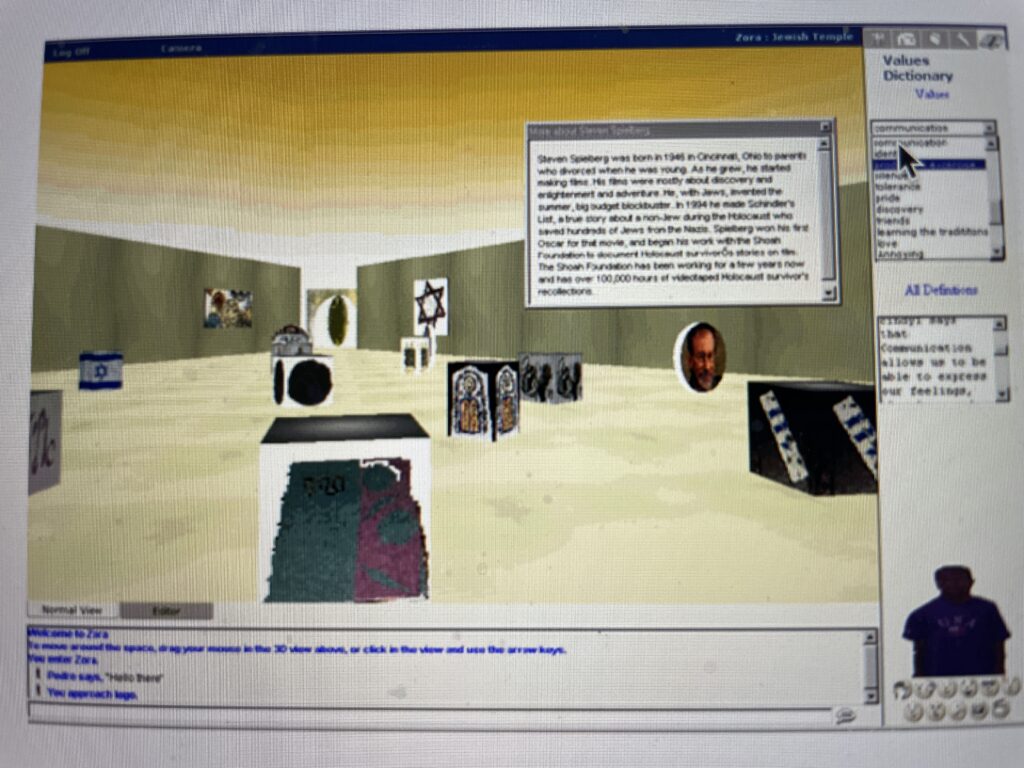Zora is a multi-user graphical environment specifically developed to help users design and inhabit a virtual city. Several users can interact and communicate with each other in real time through a chat system. Users can populate the virtual world with their own interactive creations. They can design objects, characters, personal spaces, and a virtual community. Users can select avatars to represent themselves and develop their corresponding profiles that specify personal heroes and villains, cherished values, and biographies. This three-dimensional multi-user environment engages learners in the design of a graphical virtual city and its social organization. Through the Zora projects, children and teenagers created virtual autotopographies, spatial representations of identity composed of collections of objects and characters representing aspects of themselves.
The first version of Zora was developed while Professor Marina Umaschi Bers was completing her doctoral work at the MIT Media Lab, using the Microsoft Virtual Worlds development platform. The second version of Zora was developed at Tufts University by Professor Marina Umaschi Bers, her team of students in the DevTech research group and Academic Technologies using the ActiveWorlds platform.
The design of Zora was inspired by the Jewish Sabbath, as a “palace in time”, reserved for introspection, self-reflection and community building. The Jewish philosopher and theologian Abraham Joshua Heschel wrote that the Sabbath is a “palace in time” in our modern lives: (Heschel, 1951). According to Heschel, the seventh day belongs to the realm of time, as opposed to the realm of space: a time for introspection and reflection. A time for stopping the everyday work and looking back at who we are, how we are feeling and how we are building a caring, just and responsible community. Heschel’s description inspires Zora’s design.

The Sabbath served Dr. Bers as a powerful “object to think with” and informed the kind of experience that she hoped young people would have while engaging with the virtual world. She wanted kids to enter a very special place, “a palace in time”, that would afford them similar experiences to the ones she had when entering the Synagogue: engage in self-reflection, creation, creativity, communication and participation in a community. She hoped children would collaborate with others in on-going community projects and, at the same time, engage in personally meaningful projects. She imagined them entering into “a palace in time” where they would find tools for self-reflection and community building that would go beyond the traditional prayers, words and conversations that she found at the synagogue. She wanted results of quiet introspection and self-reflection to become tangible and manipulable.
Projects
Zora @ Hospitals (Microsoft Media Player): a virtual community of transplant pediatric patients using Zora to create a peer-support network and improve medical adherence & school adjustment. This project is funded by NSF and has received additional funding from the Deborah Munroe Noonan Memorial Fund.
Zora @ Camps: a virtual community of youth affected by cancer and blood disorders that use Zora to maintain camp friendships built at Camp For All (Burton, Texas) and to improve their sense of hopefulness and social connectedness.
Zora @ Computer Clubhouses: a virtual community for pre-teens and teens participating in the national and international network of after-school computer-based learning environments, who use Zora to develop cultural awareness and respect for cultural diversity.
Zora @ Tufts: a pre-orientation for incoming freshman students who use Zora to create the campus of the future and explore connections between campus and community.
Related Papers
Cantrell, K. & Bers, M. (2010, October) Zora Camp4All: Virtual community for youth with cancer: Proceedings from the International Society of Pediatric Oncology- Pediatric Psycho-Oncology Pre-meeting, Boston, MA.
Cantrell, K., & Bers, M. (2010). Zora Camp4All: A virtual community to augment the hopefulness of pediatric camping. Child Life Focus, 28(3), 1-7.
Bers, M., Gonzalez-Heydrich, J., Raches, D., DeMaso, D. (2001). Zora: A Pilot Virtual Community in the Pediatric Dialysis Unit. (pp. 800-804). Amsterdam: IOS Press.
Bers, M. (2001). Identity Construction Environments: The Design of Computational Tools for Exploring a Sense of Self and Moral Values (Doctoral dissertation).
Bers, M., Gonzalez-Heydrich, G., DeMaso, D., Corsini, E. & Harmon, W. (2000, May). Zora: A Pilot Virtual Community in the Pediatric Dialysis Unit. Abstract accepted for American Society for Pediatrics meeting in Boston, MA.
Bers, M. (1999). Zora: a Graphical Multi-user Environment to Share Stories about the Self: Proceedings of Computer Support for Collaborative Learning, (pp. 33-40).
